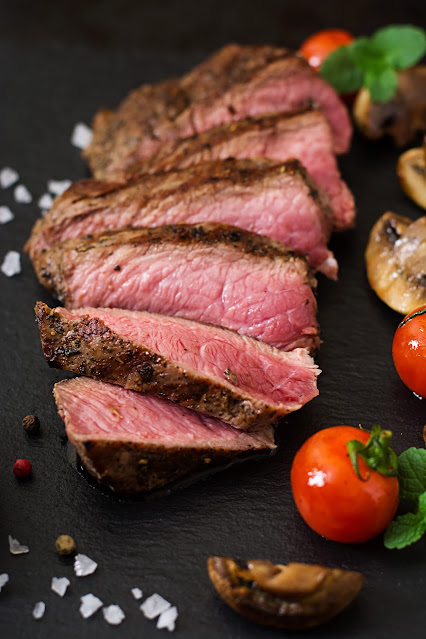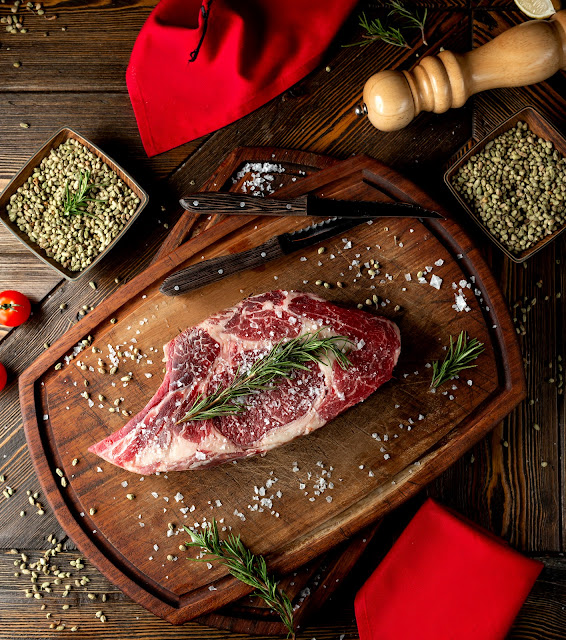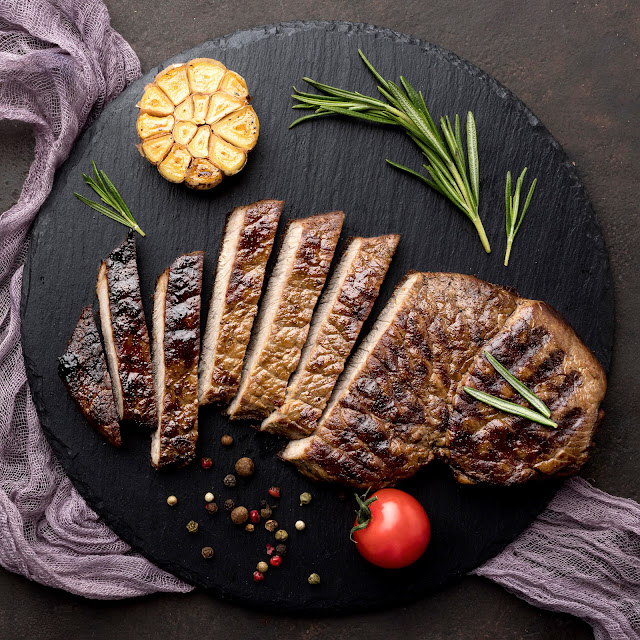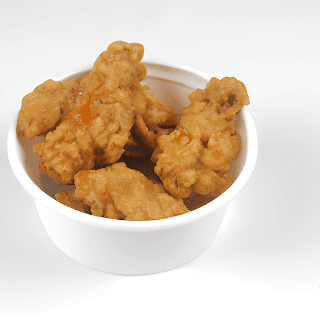Steak | Medium Rare Steak | Rare Steak
Steak:
Steak is a popular and beloved dish made from beef, although it can also be prepared from other meats like pork, lamb, or even fish. Beef steak, however, is the most well-known and widely consumed type. It is essentially a slice of meat cut perpendicular to the muscle fibers, which makes it tender and suitable for grilling, frying, or broiling.
Medium Rare Steak:
Medium rare is one of the most preferred levels of doneness for steak by many enthusiasts and chefs. To achieve a medium rare steak, it is cooked to an internal temperature of approximately 130-135°F (54-57°C). Here's what you can expect from a medium rare steak:
Color: The exterior of the steak will have a dark brown sear, while the interior will be pinkish-red, with a warm red center. The juices will be visible on the surface, giving it a moist appearance.
Texture: A medium rare steak should be tender and juicy with a slightly firm but not tough texture. It retains much of its natural beef flavor and tenderness.
Flavor: Medium rare steak offers a balanced flavor profile, with a combination of the caramelized outer crust and the juicy, pink interior. It's often considered the ideal doneness level to fully appreciate the meat's taste.
Health Considerations: Many people prefer medium rare steak for its taste and tenderness, but it's essential to ensure that the steak is sourced from a reputable supplier and cooked safely to minimize the risk of foodborne illnesses associated with undercooked beef.
Rare Steak:
Rare steak is a step further in terms of doneness, and it's favored by those who appreciate the most natural and unaltered flavors of beef. To achieve a rare steak, it is cooked to an internal temperature of approximately 120-125°F (49-52°C). Here are the characteristics of rare steak:
Color: Rare steak has a pronounced red interior, often described as cool to the touch. The outer sear is still dark brown, and it may have a slight char on the surface.
Texture: A rare steak is exceptionally tender and juicy, almost velvety in texture. It has minimal resistance when cutting or chewing.
Flavor: Rare steak offers the purest, unadulterated beef flavor, as it is minimally cooked. The sear on the outside contributes to a slightly smoky and caramelized taste.
Health Considerations: Like medium rare, rare steak should be sourced from a trusted supplier and prepared with proper food safety measures to minimize the risk of foodborne illnesses, as the interior of the steak is not fully cooked.
Certainly, here's a table comparing the health benefits and disadvantages of consuming steak, medium rare steak, and rare steak:
Aspect Steak Medium Rare Steak Rare Steak Health Benefits Protein Good source of high-quality protein Good source of high-quality protein Good source of high-quality protein Iron Rich in heme iron for red blood cells Rich in heme iron for red blood cells Rich in heme iron for red blood cells Vitamin B12 Provides essential vitamin B12 Provides essential vitamin B12 Provides essential vitamin B12 Nutrient Density Nutrient-dense with vitamins and minerals Contains vitamins and minerals Contains vitamins and minerals Health Disadvantages Saturated Fat Can be high in saturated fat Can be high in saturated fat Can be high in saturated fat Cholesterol May contain significant cholesterol May contain significant cholesterol May contain significant cholesterol Calories High in calories, potentially contributing to weight gain High in calories, potentially contributing to weight gain High in calories, potentially contributing to weight gain Cooking Methods Depending on preparation, it can involve unhealthy cooking methods Depending on preparation, it can involve unhealthy cooking methods Depending on preparation, it can involve unhealthy cooking methods Health Risks Overconsumption linked to heart disease and other health issues Overconsumption linked to heart disease and other health issues Overconsumption linked to heart disease and other health issues Note: The health benefits mentioned primarily refer to the nutritional content of beef in general. The health disadvantages focus on potential issues associated with consuming steak, regardless of its doneness level. Additionally, the preparation and cooking methods can significantly impact the health profile of steak, and it's important to consider these factors when evaluating its health effects.
FREQUENTLY ASKED QUESTIONS
Q1: Is it safe to eat steak that's cooked rare or medium rare?
A1: Yes, it can be safe to eat rare or medium rare steak if it is sourced from a reputable supplier, handled and cooked with proper hygiene, and reaches the recommended internal temperatures to kill harmful bacteria.
Q2: What are the different cuts of steak available, and which is best for rare or medium rare preparation?
A2: There are various steak cuts, including ribeye, filet mignon, sirloin, and New York strip. Tender cuts like filet mignon and ribeye are often preferred for rare or medium rare cooking due to their tenderness and flavor.
Q3: Can I achieve the perfect sear on a steak while keeping the inside rare or medium rare?
A3: Yes, you can achieve a great sear by using high heat and searing the steak briefly on each side before finishing it in the oven or on the grill to reach the desired internal temperature.
Q4: Are there any health benefits to consuming lean cuts of steak when cooked rare or medium rare?
A4: Lean cuts of steak, such as sirloin or tenderloin, when cooked rare or medium rare, can still provide the benefits of high-quality protein, B vitamins, and heme iron with fewer concerns about saturated fat.
Q5: What's the best way to check the doneness of a steak without a meat thermometer?
A5: While a meat thermometer is the most accurate method, you can use the "touch test" by comparing the steak's firmness to the feeling of your hand muscles to estimate doneness.
Q6: Are there any specific seasoning or marinade recommendations for rare or medium rare steak?
A6: Seasoning with salt and pepper is a classic choice. Marinades with herbs, garlic, and olive oil can enhance flavor, but avoid acidic marinades that may over-tenderize the meat.
PEOPLE ALSO ASK
- Steak medium rare steak rare steak cooking time
- How to cook steak medium rare steak rare steak
- medium rare steak temperature
- medium-rare steak time
- is medium rare steak safe
- blue rare steak





Comments
Post a Comment